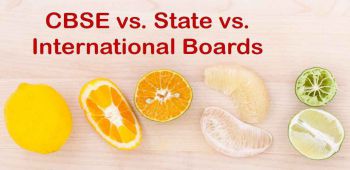The new and updated curriculum makes sure that the syllabus is not heavy and at the same time is comparable to the international level of education. The knowledge related to this subject has undergone humungous changes in the past one decade. Many new areas like natural resources, synthetic materials, bio -molecules, industrial chemistry are coming in a big way and deserve to be an integral part of chemistry syllabus at senior secondary stage. At the international level, new formulations and nomenclature of elements and compounds, symbols and units of physical quantities floated by scientific bodies like IUPAC and CGPM are of immense importance and need to be incorporated in the updated syllabus which is taken care of in the revised syllabus. Also greater emphasis has been laid on use of new nomenclature, symbols and formulations, teaching of fundamental concepts, application of concepts in chemistry to industry/ technology, logical sequencing of units, removal of obsolete content and repetition, etc.
Name of the Units and their weightage in the Board Exam
|
Units |
Marks |
|
Solid State |
4 |
|
Solutions |
5 |
|
Electrochemistry |
5 |
|
Chemical Kinetics |
5 |
|
Surface Chemistry |
4 |
|
General Principles & Processes of Isolation of Elements |
3 |
|
p-Block Elements |
8 |
|
d & f-Block Elements |
5 |
|
Co-ordination Compounds |
3 |
|
Haloalkanes & Haloarenes |
4 |
|
Alcohols, Phenols & Ethers |
4 |
|
Aldehydes, Ketones & Carboxylic Acids |
6 |
|
Organic Compounds Containing Nitrogen |
4 |
|
Biomolecules |
4 |
|
Polymers |
3 |
|
Chemistry in Everyday Life |
3 |
Details of topics and sub-topics to be covered in each unit
Unit I: Solid State
Classification of solids based on different binding forces: molecular, ionic, covalent and metallic solids, amorphous and crystalline solids (elementary idea). Unit cell in two dimensional and three dimensional lattices, calculation of density of unit cell, packing in solids, packing efficiency, voids, number of atoms per unit cell in a cubic unit cell, point defects, electrical and magnetic properties.
Band theory of metals, conductors, semiconductors and insulators and n & p type semiconductors.
CBSE Class 12th Chemistry Notes: All Chapters
Unit II: Solutions
Types of solutions, expression of concentration of solutions of solids in liquids, solubility of gases in liquids, solid solutions, colligative properties - relative lowering of vapour pressure, Raoult's law, elevation of boiling point, depression of freezing point, osmotic pressure, determination of molecular masses using colligative properties, abnormal molecular mass, Van't Hoff factor.
Unit III: Electrochemistry
Redox reactions, conductance in electrolytic solutions, specific and molar conductivity, variations of conductivity with concentration, Kohlrausch's Law, electrolysis and law of electrolysis (elementary idea), dry cell-electrolytic cells and Galvanic cells, lead accumulator, EMF of a cell, standard electrode potential, Nernst equation and its application to chemical cells, Relation between Gibbs energy change and emf of a cell, fuel cells, corrosion.
Unit IV: Chemical Kinetics
Rate of a reaction (Average and instantaneous), factors affecting rate of reaction: concentration, temperature, catalyst; order and molecularity of a reaction, rate law and specific rate constant, integrated rate equations and half life (only for zero and first order reactions), concept of collision theory (elementary idea, no mathematical treatment). Activation energy, Arrhenious equation.
Unit V: Surface Chemistry
Adsorption - physisorption and chemisorption, factors affecting adsorption of gases on solids, catalysis, homogenous and heterogeneous activity and selectivity; enzyme catalysis colloidal state distinction between true solutions, colloids and suspension; lyophilic, lyophobic multi-molecular and macromolecular colloids; properties of colloids; Tyndall effect, Brownian movement, electrophoresis, coagulation, emulsion - types of emulsions.
Unit VI: General Principles and Processes of Isolation of Elements
Principles and methods of extraction - concentration, oxidation, reduction - electrolytic method and refining; occurrence and principles of extraction of aluminium, copper, zinc and iron.
Unit VII: p - Block Elements
Group 15 Elements: General introduction, electronic configuration, occurrence, oxidation states, trends in physical and chemical properties; Nitrogen, preparation properties & uses ; compounds of Nitrogen, preparation and properties of Ammonia and Nitric acid, Oxides of Nitrogen (Structure only) ; Phosphorus - allotropic forms, compounds of Phosphorus: preparation and properties of Phosphine, Halides and Oxoacids (elementary idea only).
Group 16 Elements: General introduction, electronic configuration, oxidation states, occurrence, trends in physical and chemical properties,dioxygen: Preparation, Properties and uses, classification of oxides, Ozone, Sulphure -allotropic forms; compounds of sulphure: Preparation properties and uses of sulphur-dioxide, sulphuric acid: industrial process of manufacture, properties and uses; Oxoacids of Sulphur (Structures only).
Group 17 Elements: General introduction, electronic configuration, oxidation states, occurrence, trends in physical and chemical properties; compounds of halogens, Preparation properties and uses of chlorine and hydrochloric acid, interhalogen compounds, Oxoacids of halogens (structures only).
Group 18 Elements: General introduction, electronic configuration, occurrence, trends in physical and chemical properties, uses.
Unit VIII: d and f Block Elements
General introduction, electronic configuration, occurrence and characteristics of transition metals, general trends in properties of the first row transition metals - metallic character, ionization enthalpy, oxidation states, ionic radii, colour, catalytic property, magnetic properties, interstitial compounds, alloy formation, preparation and properties of K2Cr2O7 and KMnO4.
Lanthanoids - Electronic configuration, oxidation states, chemical reactivity and lanthanoid contraction and its consequences.
Actinoids - Electronic configuration, oxidation states and comparison with lanthanoids.
Unit IX: Coordination Compounds
Coordination compounds - Introduction, ligands, coordination number, colour, magnetic properties and shapes, IUPAC nomenclature of mononuclear coordination compounds. Bonding, Werner's theory, VBT, and CFT; structure and stereo isomerism, importance of coordination compounds (in qualitative inclusion, extraction of metals and biological system).
Unit X: Haloalkanes and Haloarenes
Haloalkanes: Nomenclature, nature of C-X bond, physical and chemical properties, mechanism of substitution reactions, optical rotation.
Haloarenes: Nature of C -X bond, substitution reactions (Directive influence of halogen in monosubstituted compounds only.
Uses and environmental effects of - dichloromethane, trichloromethane, tetrachloromethane, iodoform, freons, DDT.
Unit XI: Alcohols, Phenols and Ethers
Alcohols: Nomenclature, methods of preparation, physical and chemical properties (of primary alcohols only), identification of primary, secondary and tertiary alcohols, mechanism of dehydration, uses with special reference to methanol and ethanol.
Phenols: Nomenclature, methods of preparation, physical and chemical properties, acidic nature of phenol, electrophilic substitution reactions, uses of phenols.
Ethers: Nomenclature, methods of preparation, physical and chemical properties, uses.
Unit XII: Aldehydes, Ketones and Carboxylic Acids
Aldehydes and Ketones: Nomenclature, nature of carbonyl group, methods of preparation, physical and chemical properties, mechanism of Nucleophilic addition, reactivity of alpha hydrogen in Aldehydes: uses.
Carboxylic Acids: Nomenclature, acidic nature, methods of preparation, physical and chemical properties; uses.
Unit XIII: Organic compounds containing Nitrogen
Amines: Nomenclature, classification, structure, methods of preparation, physical and chemical properties, uses, identification of primary, secondary and tertiary amines.
Cyanides and Isocyanides - will be mentioned at relevant places in context.
Diazonium salts: Preparation, chemical reactions and importance in synthetic organic chemistry.
Unit XIV: Biomolecules
Carbohydrates - Classification (aldoses and ketoses), monosaccahrides (glucose and fructose), D-L configuration oligosaccharides (sucrose, lactose, maltose), polysaccharides (starch, cellulose, glycogen); Importance of carbohydrates.
Proteins - Elementary idea of - amino acids, peptide bond, polypeptides, proteins, structure of proteins - primary, secondary, tertiary structure and quaternary structures (qualitative idea only), denaturation of proteins; enzymes. Hormones - Elementary idea excluding structure.
Vitamins - Classification and functions.
Nucleic Acids: DNA and RNA.
Unit XV: Polymers
Classification - natural and synthetic, methods of polymerization (addition and condensation), copolymerization, some important polymers: natural and synthetic like polythene, nylon polyesters, bakelite, rubber. Biodegradable and non-biodegradable polymers.
Unit XVI: Chemistry in Everyday Life
Chemicals in medicines - analgesics, tranquilizers antiseptics, disinfectants, antimicrobials, antifertility drugs, antibiotics, antacids, antihistamines.
Chemicals in food - preservations, artificial sweetening agents, elementary idea of antioxidants.
Cleansing agents - soaps and detergents, cleansing action.
Prescribed books
(1) Chemistry Part-I, Class-XII, Published by NCERT.
(2) Chemistry Part-II, Class-XII, Published by NCERT.
TIPS AND TRICKS:
Here are a few last-minute tips to score well on your Class 12 Chemistry paper:
1. Skim through the NCERT books from cover to cover
As per the trends of the last few years, the Class 12 Boards question paper has questions all from the NCERT. So, you will need to remember every example of reactions, both organic and inorganic.
When practicing numericals, make sure you cover all the examples in between chapters and the exercise questions at the end of each chapter.
2. Concentrate on the units with the highest weightage
The following units hold the highest weightage for Class 12 Chemistry Board exams in decreasing order:
- p-Block Elements
- Aldehydes, Ketones and Carboxylic acids
- d-and f-Block Elements
- Solutions
- Electrochemistry
- Chemical Kinetics
Check out the chapter-wise marking division here.
3. Go through previous years' question papers
Questions are often repeated in Chemistry and solving previous years' question papers goes a long way to helping you ace in your Chemistry exams as it helps you with time management long with an understanding of the question pattern.
If you haven't been solving these papers, don't waste your time at this last minute. Instead, sit with a solved question paper book of previous years and go through each and every question.
Solve the trickier numericals in your notebook and mark the kind of Reaction questions asked often.
4. Memorise the formulae for Physical Chemistry
If you are good at Maths, you might find Physical Chemistry right up your alley. Physical Chemistry constitutes of Units 1 to 5 and constitutes a total of 23 marks. Write down and memorise all the formulae and make sure you solve at least one or two questions of the style you find most difficult.
Take the help of reference books to find several problems of similar styles to practice.
5. Practice Reasoning type Organic and Inorganic questions
In such questions, make sure you provide the correct reasons. The previous years' questions will help you understand what kinds of questions are likely to be asked. In Organic questions of this type, provide the suitable diagram as well.
6. Concentrate on p-Block elements and Coordination Compounds chapters for Inorganic Chemistry
Inorganic Chemistry is a good target area for those who are good at theory. Units 6-9 which constitute Inorganic Chemistry carry a total of 19 marks. Memorising the reactions are very important here. You can expect around 8 marks or more to be asked from p-Block.
Noble gases and Halogens are important topics and often have questions asked from them. Practice these areas well.
From p-Block chapter, also practice drawing the structures of the different elements.
p-Block and d-Block elements cannot be learned quickly but if you have notes, it will be quick to revise.
7. Named reactions and conversions are very important
Units 10 to 16 constitute Organic Chemistry and this 29-mark portion is the heaviest bulk of the Class 12 Chemistry Board exam. True Chemistry lovers probably enjoy this section and don't even consider it too difficult.
Named reactions are very important, as are questions such as Nucleophilic substitution/addition, Electrophilic substitution/addition.
Also revise and practice a couple of step-by-step conversion questions from one compound to another.
8. Practice IUPAC naming and the identification of compounds through different agents
IUPAC naming of compounds is important for 1-mark questions. You should go through the rules and practice a couple to make sure you understand this.
Vert short answer type questions can be asked on the identification of compounds though different agents and you should practice the same.
9. The last three chapters can fetch you 10 solid marks
The last three chapters of the book need to be read and learned mostly and you can score a solid 10 marks from the chapters Biomolecules, Polymers, and Chemistry in Everyday life.
So, take a breather and get on with your revision. Sleep for at least 6 hours and don't freeze during the exam. All the best!




















Comments